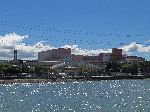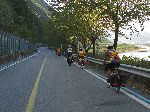Ibike Korea People-to-People Program
 Photo essay:
Seomjin River -
Photo essay:
Seomjin River -
Gwangyang, Hadong, Ssanggye-sa, Gurye
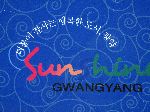
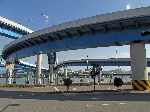
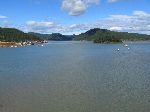 The
slogan for Gwangyang County is simple "Sunshine". That certainly has been
the prevailing daytime weather this day.
The
slogan for Gwangyang County is simple "Sunshine". That certainly has been
the prevailing daytime weather this day.The Seomjingang Trail begins at the mouth of the river, which is crocheted with expressway ramps.
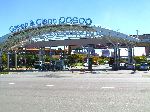
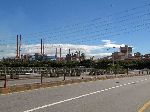 The
demand for the extensive transportation infrastructure come from the nearby POSCO Gwangyang Steelworks
and the Gwangyang Bay Free Economic Zone.
The
demand for the extensive transportation infrastructure come from the nearby POSCO Gwangyang Steelworks
and the Gwangyang Bay Free Economic Zone.
The steelworks is the largest steel plant in the world. They claim they have the most modern
technology, and the best facilities for steel manufacturing. It presently
produces coil used for making bridges, iron structures, cars, refrigerators, and
more. Its production capacity averages about 18 million tons per year. This
plant is also a tourist trap attracting more than 300,000 people from around the
world.
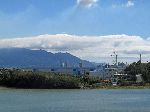 POSCO was formed in 1968 as a government self-sufficiency initiative and
began producing in 1972, in Pohan. It was privatized in 1998.
POSCO was formed in 1968 as a government self-sufficiency initiative and
began producing in 1972, in Pohan. It was privatized in 1998.
In addition to steel, there are cement, chemical and other heavy industry factories in Gwangyang.
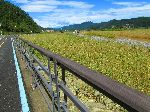
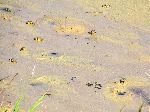
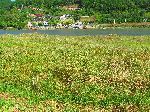 The
lower reach of the Seonjingang is tidal. A lot of the shoreline habitat is reeds
and estuary.
The
lower reach of the Seonjingang is tidal. A lot of the shoreline habitat is reeds
and estuary.
At low tide some mudflats appear and small crabs pop out of their burrows (right).
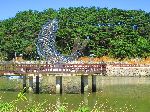
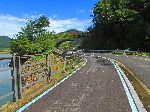 To
celebrate the fishing culture in the mouth of the river and extending to the
islands offshore, a fish sculpture (left) enhances a village park.
To
celebrate the fishing culture in the mouth of the river and extending to the
islands offshore, a fish sculpture (left) enhances a village park.The trail continues to evolve as each year new construction (especially 2014-16) creates separate lanes for non-motorized users, so they can move off the adjacent roads (right).
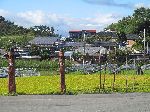
Jang-seung are a male-female pair of wooden spirit posts representing the earthly and heavenly gods. Usually locate at the entrance to a village scare off evil. They are smiling scary.
So-ttae traditionally marked the boundaries of a village and were for good luck. Contemporarily they are used more as decorative art.
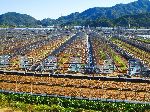
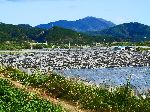 Moving
further inland, aquaculture is replaced by agriculture. While much of the
agriculture in Korea is rice, in this valley there was and expanse of greenhouse
or greenhouse frames (currently uncovered). These are generally used for
vegetable farming and horticulture.
Moving
further inland, aquaculture is replaced by agriculture. While much of the
agriculture in Korea is rice, in this valley there was and expanse of greenhouse
or greenhouse frames (currently uncovered). These are generally used for
vegetable farming and horticulture.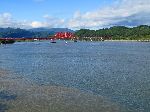 There
is a reoccurring theme in Korea of new bridges. The construction on this bridge
seem to be pretty complete (2016), but there is an abrupt drop-off on the
eastern approach (right side) and there is no apparent road on its way. On the
western side (left), the road leads into a hill, but a tunnel has been built..
There
is a reoccurring theme in Korea of new bridges. The construction on this bridge
seem to be pretty complete (2016), but there is an abrupt drop-off on the
eastern approach (right side) and there is no apparent road on its way. On the
western side (left), the road leads into a hill, but a tunnel has been built..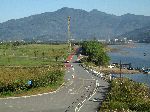 For
most of the distance from Gwangyang to Hadong the Seomjingang Trail follows closely
follows the river on a separate trail. The river bends gently along the valley
floor, generally without a perceptible current. It is broad and bounded by
rolling hills.
For
most of the distance from Gwangyang to Hadong the Seomjingang Trail follows closely
follows the river on a separate trail. The river bends gently along the valley
floor, generally without a perceptible current. It is broad and bounded by
rolling hills.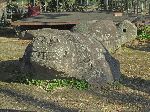
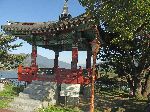 The
sign nearby describes the stone toads as the "clumsy sculpture technique of the
Joseon Dynasty. The mouth is toothless, the feet are simple and the head is
looks more like a turtle. That be as it is, they have created a whole park
around the clumsy turtle.
The
sign nearby describes the stone toads as the "clumsy sculpture technique of the
Joseon Dynasty. The mouth is toothless, the feet are simple and the head is
looks more like a turtle. That be as it is, they have created a whole park
around the clumsy turtle.The pavilion provide a shaded place to relax and watch the Seomjingang (river).
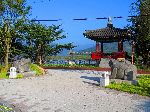
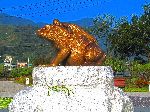
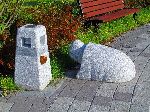
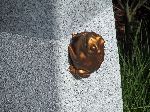
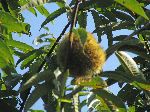
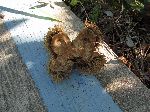
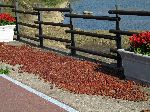 Chestnut are one of the major crops along the lower Seomjingang.
Here they are seen hanging on a tree, the husk opened and hundreds drying along
the side of bike trail.
Chestnut are one of the major crops along the lower Seomjingang.
Here they are seen hanging on a tree, the husk opened and hundreds drying along
the side of bike trail.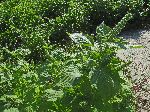
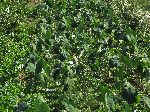
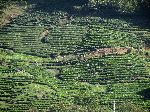
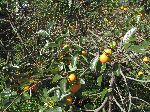
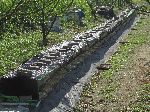 Other major agricultural products for the district that border the route
include;
sesame or perilla, taro or toran (or depending upon where you are in the world; eddo
(Caribean), cocoyam (West Africa), dasheen (America), elephant ear plant, yu tou
(China), woo choi (China), and sato-imo or kimo (Japan) to name a few), tea, persimmon,
and honey (beehives).
Other major agricultural products for the district that border the route
include;
sesame or perilla, taro or toran (or depending upon where you are in the world; eddo
(Caribean), cocoyam (West Africa), dasheen (America), elephant ear plant, yu tou
(China), woo choi (China), and sato-imo or kimo (Japan) to name a few), tea, persimmon,
and honey (beehives).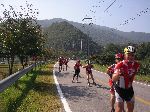
If you pass this area (Maehwa Village) in the spring you will be treated to the display of 100,000 plum (or apricot) trees in bloom. In Korea tradition, there is a festival that coincides with it in mid-march.
Across the river is Pyeongsa-ri, the main setting for renown Korean woman writer Park Gyeong-ri’s (1926-2008) (not to be confused with the K-pop singer and model of the same name) epic, sixteen volume saga Toji (The Land). It has been made into a TV series, a movie, and an opera.
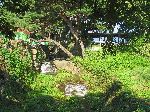
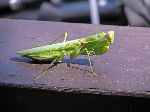
View from the Seomjin River Trail (left)
Praying mantis (right)
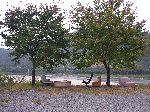
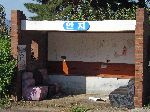 Old furniture isn't sent to the land fill, it is
sent to the river bank and bus shelters for repurposing. It is amusing to
pass a bus shelter and see a big, overstuffed chair in it. Or, to see a
cluster of old furniture resting in the shade of some trees with a good view of
a river and mountains, waiting to be occupied.
Old furniture isn't sent to the land fill, it is
sent to the river bank and bus shelters for repurposing. It is amusing to
pass a bus shelter and see a big, overstuffed chair in it. Or, to see a
cluster of old furniture resting in the shade of some trees with a good view of
a river and mountains, waiting to be occupied.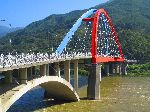
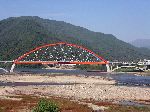
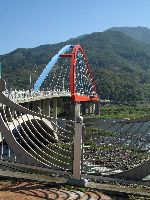 The
Namdo bridge
(new in 2004) crosses the Seomjingang (river) at Hwagae Village.
It has nice curves and lines standout in the valley. It is not better than the
natural beauty, but its artistry catches the eye.
The
Namdo bridge
(new in 2004) crosses the Seomjingang (river) at Hwagae Village.
It has nice curves and lines standout in the valley. It is not better than the
natural beauty, but its artistry catches the eye.
![]() Hwagae Village, Tea Country,
Ssanggyesa (side trip)
Hwagae Village, Tea Country,
Ssanggyesa (side trip)
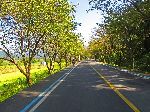

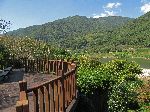
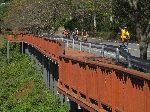
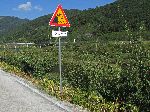
North of Namdo Bridge parts of the Seomjingang Trail are co-located on the road, but the traffic volumes is so low that most of the time it is like an over-size dedicated bike facilities. The generally flat route looks out onto the river, rice fields and reed beds, with a backdrop of forested hills. The street trees are in the Prunus genus (probably cherry) so in leave they are elegant, but when they are in bloom the road must be absolutely gorgeous. Some of the engineer to accommodate all of the modes is very impressive, including miles of pedestrian viaduct build above the .
Once a river it seems to be necessary to photo the "bicycle-be-cautious-not-to-run-off-the-road sign.
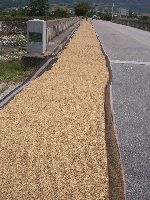

It always nice to find yourself on a road with rice, peppers, beans or other produce drying on the road. It means the locals don't expect much traffic so you don't have to either. But if the traffic gets to heavy you end up with tire tracks in the rice (right).
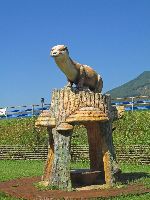
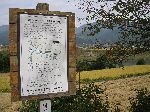
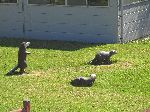 The sign explains, maps and gives the policies for
the Eurasian Otter Habitat Eco-System Conservation Area on the Seomjin River. This
is a radical departure from the enormous amount of narrow river channelization and
river bed habitat degradation seen on other rivers, and other sections of the
Seomjin River.
The sign explains, maps and gives the policies for
the Eurasian Otter Habitat Eco-System Conservation Area on the Seomjin River. This
is a radical departure from the enormous amount of narrow river channelization and
river bed habitat degradation seen on other rivers, and other sections of the
Seomjin River.
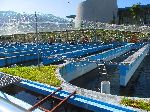 A
few members of our groups have seen live otters, but it is easier to photograph
the statues at the
A
few members of our groups have seen live otters, but it is easier to photograph
the statues at the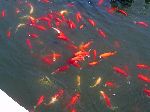 adjacent otter research center and the Seomjin River Fish Eco-Museum.
adjacent otter research center and the Seomjin River Fish Eco-Museum.
The museum seems to be set-up like a fish hatchery, but it is not clear if the fish are intended for release into the river. Carp, or Koi, is just one of the types of fish that is being reared.
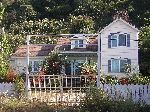
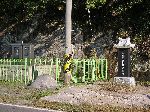
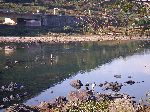
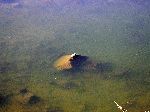 While fishermen space
themselves across the river (left) a turtle (right) near the shore catches the
last few warming rays of afternoon sun.
While fishermen space
themselves across the river (left) a turtle (right) near the shore catches the
last few warming rays of afternoon sun.Seomjingang River (섬진강) boasts the cleanest water among Korea’s five largest rivers. People gathering Jaecheop (clean water clams), below the farm at Maehwa, in the mud flats of the Seomjingang River,
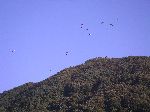 Para-gliders circle like
a large flock of condors, playing in the
updrafts around a mountain near Gurye.
Para-gliders circle like
a large flock of condors, playing in the
updrafts around a mountain near Gurye.
![]() Beolgyo
(southern route)
Beolgyo
(southern route)
 Please
contact us if you would like to be added to
Ibike's mailing list or have questions, comments, corrections or criticism. (Also, please let us know how you learned about us and
found this site.) Privacy policy.
Please
contact us if you would like to be added to
Ibike's mailing list or have questions, comments, corrections or criticism. (Also, please let us know how you learned about us and
found this site.) Privacy policy.
![]() IBF Homepage
IBF Homepage ![]() Ibike Programs
Ibike Programs
![]() Ibike Schedule
Ibike Schedule
![]() Search
Search
